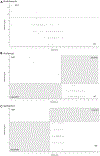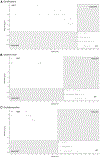Epidemiological Cutoff Values for Standard Broth Microdilution and Disk Diffusion Susceptibility Testing of Aeromonas hydrophila Isolated from Fish
- PMID: 35972765
- PMCID: PMC11421686
- DOI: 10.1089/mdr.2021.0316
Epidemiological Cutoff Values for Standard Broth Microdilution and Disk Diffusion Susceptibility Testing of Aeromonas hydrophila Isolated from Fish
Abstract
Aeromonas hydrophila and other closely related Aeromonas species cause motile aeromonad septicemia, a common fish disease. The disease affects many aquaculture sectors potentially requiring antimicrobial treatments. Therefore, researchers and laboratory diagnosticians need criteria called epidemiological cutoff values (ECVs) to determine whether a bacterial isolate has developed decreased susceptibility to an antimicrobial. To generate ECVs for this bacterium, we assembled a diverse collection of 245 isolates previously identified as A. hydrophila from fish. Using rpoD sequencing, we confirmed that 97 of the 245 isolates were A. hydrophila. We allocated the isolates among three laboratories and tested their susceptibility against eight antimicrobials using standard Clinical and Laboratory Standards Institute (CLSI) disk diffusion and broth microdilution methods. The resulting frequency distributions were statistically analyzed to determine wild-type cutoff estimates, which, along with scatterplots, were used to estimate potential ECVs. In collaboration with the CLSI, aquaculture working group, we proposed ECVs for six of the eight antimicrobials tested. Subsequently, the CLSI Subcommittee on Veterinary Antimicrobial Susceptibility Testing reviewed our data and approved the ECVs to be added to the 2020 edition of the VET04 performance standards for antimicrobial susceptibility testing of aquatic bacteria.
Keywords: Aeromonas hydrophila; epidemiological cutoff values; fish; motile aeromonad septicemia.
Conflict of interest statement
Disclosure Statement
No competing financial interests exist.
Figures


References
-
- Beaz-Hidalgo R, Alperi A, Buján N, Romalde JL, and Figueras MJ. 2010. Comparison of phenotypical and genetic identification of Aeromonas strains isolated from diseased fish. Syst. Appl. Microbiol 33:149–153. - PubMed
-
- Jagoda SS, Wijewardana TG, Arulkanthan A, et al. 2014. Characterization and antimicrobial susceptibility of motile aeromonads isolated from freshwater ornamental fish showing signs of septicemia. Dis. Aquat. Org 109: 127–137. - PubMed
-
- Parker JL, and Shaw JG. 2011. Aeromonas spp. clinical microbiology and disease. J. Infec 62:109–118. - PubMed
-
- Scarano C, Piras F., Virdis S, et al. 2018. Antibiotic resistance of Aeromonas ssp. strains isolated from Sparus aurata reared in Italian mariculture farms. Int. J. Food Microbiol 284:91–97. - PubMed
MeSH terms
Substances
Grants and funding
LinkOut - more resources
Full Text Sources
Molecular Biology Databases

